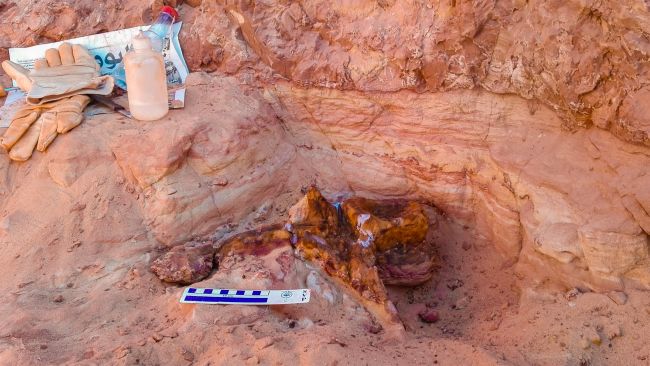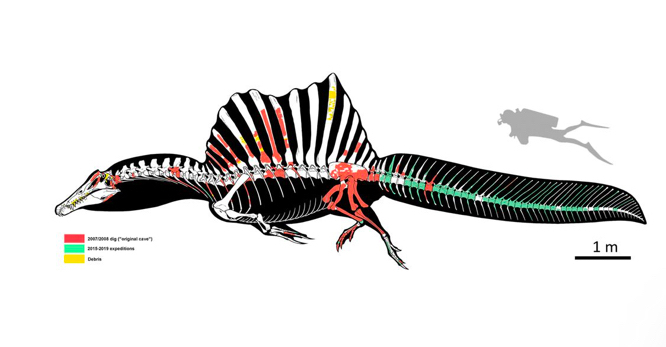Welcome back to our Science Odyssey Contest event, where we're posting STEM articles from May 2 to May 17. To enter, you can find details at the bottom of this post.
In the world of prehistoric reptiles, there are two basic camps.
There are the beasts that are so well known, they practically seem alive now — Tyrannosaurus rex, Triceratops, Brachiosaurus, Iguanodon, and Velociraptor, for example. And there are the barely known creatures — Bajadasaurus, Corythoraptor, Ambopteryx, and Wulong bohaiensis are just a few of this very wide-ranging clan.
And then... you have Spinosaurus. On one hand, this titanic predator has the unique distinction of besting a T. rex head-to-head in Jurassic Park III.
But while fun to watch, that was just the movies. In truth, the real life version of this enormous animal has been a controversial topic for decades. Now, a newly released study in Nature on a Spinosaurus tail fossil may finally give us the dino-truth.
The largest land carnivore to have ever lived? Probably.
But where Spinosaurus really shone was in the water.
Spinosaurus: the great debate
Before we get to this new discovery, let's take a look at where our knowledge of this dinosaur was before this happened.
The first fossil was discovered over a century ago, in 1915. But since then, follow-up fossils were slow in coming and, like so many fossils, frustratingly incomplete. Add on to that the fact that several of the few known fossils were destroyed by Allied bombing of Germany during WWII, and you get an intriguing puzzle.
Spinosaurus' stunning spine sail (where it gets the name "spine lizard") was intact. As was its extremely long, narrow jaw and cone-shaped teeth — with its similarities to modern crocodilians, scientists generally agreed that this animal ate a lot of fish and slippery marine creatures. (And NOT, say, T. rexes.)
But experts were split on how the animal hunted and lived. Many said that it would wade into shallow water, like a brown bear hunting fish, rarely losing contact with land. Others believed that it was more of a full-on swimmer — able to dive and chase after prey in more open water.
And the one part of its fossil that would best solve this riddle was the part that was missing in all fossils.
The tail.
Heads AND tails

A picture of the caudal, or tail, bones of a Spinosaurus being excavated in 2018 in Morocco. (Diego Mattarelli)
Now, thanks to a team led by paleontologist Nizar Ibrahim of the University of Detroit Mercy, this debate appears to be settled.
On a 2018 expedition to Morocco in North Africa, Ibrahim discovered the long desired tail of the Spinosaurus. And its bones showed not a thin, tapering tail as on most other theropods (carnivores). Instead, it had more tall bones, completing a paddle-like appendage. Perfect for, you guessed it, swimming!
The result means that Spinosaurus is the first dinosaur ever to be confirmed as a swimmer. (Remember, that aquatic reptiles like pleisosaurs and mosasaurs were not dinosaurs.) And alongside with breakthroughs in feathered fossils, it shows just how much mystery is left in our planet's prehistoric past.
Watch Ibrahim discuss his incredible find in the Nature video below.
Contest alert
Don't miss our Science Odyssey Contest. Click HERE TO ENTER.

 Newly discovered tail bones — shown in green — have completely changed our view of this amazing animal. (Marco Auditor)
Newly discovered tail bones — shown in green — have completely changed our view of this amazing animal. (Marco Auditor)










it was interesting but also boring dinosaurs are dead if they can swim cool but it doesn’t matter. I feel like there are more important thing to talk about. : )
I don’t really agree. I think Dinosaurs are the coolest things on earth! Much more exciting than humans anyway